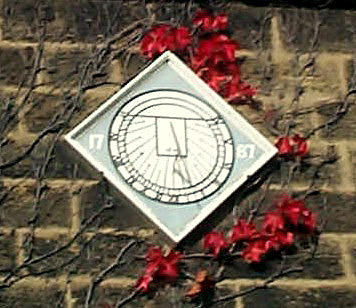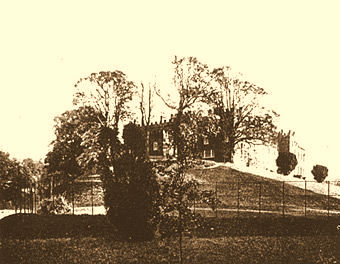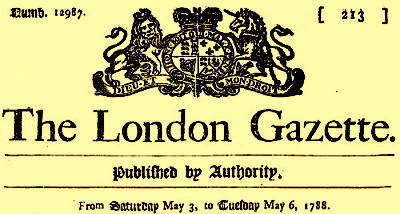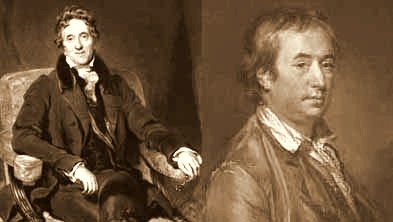1785
17th February –
SKELTON SQUIRE HAS MONEY PROBLEMS AND “UNHAPPY MARRIAGE”.
It appears that by this time John Hall Stevenson of Skelton Castle had become a hypochondriac. Sterne suggested that he was one all along.
In a letter to his Grandson of this date he speaks of financial problems.
He also claims to have not enjoyed many pleasures in life, despite the reports of the Demoniacs and bawdy deeds at the Castle.
He blames this on an unhappy marriage which he entered at too young an age.
March –
DEATH OF JOHN HALL STEVENSON.
He died at the age of 67, 52 years after inheriting Skelton estate.
He was succeeded by his son Joseph William Hall-Stevenson.

1786
NEW SQUIRE DIES WITHIN A YEAR OF INHERITING.
Death of Joseph William Hall-Stevenson, aged 45, just one year after inheriting Skelton estate. He was married to Anne, the daughter of James Forster of Drumgoon, Co Fermanagh, Ireland. They had 5 children, John, Fanny, Margaret, William [who became vicar of Gilling], and James [who became a Major General in the 21st Light Dragoons].
He was succeeded by his son John Hall-Stevenson.

1787
NEW TAXES.
Income tax had not yet been introduced, but the Government gathered revenue in other ways.
Receivers were appointed and collected taxes quarterly on :-
Land [4 shillings in every 20 that the land could be leased for]
Windows [on all houses having more than 6 windows]
As well as on Houses, Shops, Servants, Carriages, Wagons, Carts and horses.
November –
YOUNG SKELTON SQUIRE TO ENTER NATIONAL POLITICS.
John Hall Stevenson, known at that time as “Hall of Skelton” showed his intention of entering the world of Politics, which was then purely the preserve of the monied class, by informing the Whig interest in Yorkshire that he intended to “purchase” a seat in Parliament.
He was just 22 years of age, with good intentions, but a seeming naivety that eventually brought about his downfall.
He was described at this time by some as –
‘a man of great abilities, a declared man of the party, of some interest and large property’. ‘he is a good sensible, lively young man, and is the nephew of old Peg Wharton to whom she last year gave an hundred and fifty thousand pounds in the three per cents.
He is also heir to her landed estates.’

on which the old Castle was probably built for defence.

1788
THE NAME OF STEVENSON AT THE CASTLE REPLACED BY WHARTON.
On May 6th in this year John Hall Stevenson changed his name by “royal sign manual” to John Wharton.
This change of name was at the request or perhaps ultimatum of his rich aunt, Margaret Wharton, whose fortune he inherited in 1791.
MARGARET WHARTON – PEG PENNYWORTH.
Baines gazetteer records:-
“This lady whose habits were of the most saving kind as far as her own personal expenses were concerned possessed a fortune of £200,000 and amongst the rest of her oddities chose to act as her own executrix and actually made a present during her own lifetime of £100,000 to her nephew, the present worthy possessor of Skelton Castle.”
THE OLD SKELTON CASTLE DEMOLISHED AND REBUILT.
Using his new found wealth John Wharton had the old castle was torn down and the present one built.
He was condemned at the time by many for destroying a piece of History.
“He commenced the work of destruction and, at enormous expense, contrived to flood the glen, demolish the terraces, pull down every remnant of Norman antiquity, including a magnificent tower;
and has left behind him the most extraordinary specimen of folly and bad taste to be found in the whole country.”
But Baines gazetteer of 1823 thought otherwise:-
“It presents an elegant, extended front, situated on the brink of a rivulet which by being collected into a reservoir with sloping banks adds greatly to the natural beauties of the place”
The plans for the new Castle were drawn by Sir John Soane R,A. in 1787.
Soane was born in 1753 and became the leading architect of his day, being made Professor of Architecture at the Royal Academy in 1809.
He created new ideas for internal design and lighting and among many new structures and alterations around the country was responsible for a new Bank of England building in London and the state dining room at 10 Downing St.
His own house in Lincoln Inn Fields in London is now the Sir John Soane Museum.
His designs were often carried out by a local builder so what was built is an interpretation of his ideas. Soanes archives state for Skelton Castle:-
“Skelton Hall, Yorks/ John Hall (later Wharton)/ Rebuilding of house: Alts to house, new kitchen wing, lodges and stables/Rebuilding unexecuted; All else executed and extant, except lodges which are possibly unexecuted and now demolished”
Prior to these changes entry to the Castle had always been directly in front, by what is now Church Lane, leading to old Boroughgate Lane.
Now a new entrance and lodge was built on Guisborough Rd, just past Barns Farm.
This was still in use in 1895 and presumably demolished when the present Lodge was built on Marske Rd in 1903.
The alterations took some 30 years to complete and other architects involved were Sir William Chambers and Ignatius Bonomi, of North East Railways fame.
The exact layout of the old Castle castle is unknown.
Some evidence comes in the form of a letter from a clergyman recorded in Ord’s History of Cleveland (1846), accompanied by a sketch of the castle.
The clergyman claimed to have watched the castle being demolished in 1788, sixty years before Ord was writing.
His sketch shows the castle as being on a terrace, with a low curtain wall, possibly square in form. Square towers are show at two of the visible corners, a round tower (also said to be a dovecote) at the front-right. A keep is shown on the left.


Architects involved in the rebuilding of Skelton Castle
7th August –
THE SKELTON SOCIETY FOR THE PROSECUTION OF FELONS ESTABLISHED.
A group of Skelton landowners and businessmen had got together during the previous year to consider how to combat losses that they suffered at the hands of offenders.
On this day they formally established the “Skelton Society for the Prosecution of Felons”.
Similar local organisations had existed elsewhere in Britain for some time.
The village Church Vestry was the “local Council” of the time and responsible for carrying out the various directions of the “Poor Law” in relation to the collection and spending of the Parish “rates” of the time.
One of these regulations was to appoint a village “Constable”, who was responsible for arresting vagrants etc, but he did not have any of the powers of the modern day Police.
Back then, there was no Police Force as we know it.
The North Riding Police Force was not established until 1856.
See here for “Skelton Crime Watch”.
Within small villages, where people were very much related and dependent on each other crime was rare, but nationwide it had been growing and the local landowners and tradesmen of Skelton decided to follow the advice of the more travelled Squire, John Wharton.
To bring an offender to Court in those times involved expenses that were often beyond even the reasonably well-to-do tradesman.
One prosecution in the next few years involved the theft of 3 pence worth of Oats and the costs were over 20 pounds in lawyers fees, witnesses expenses etc.
Felons Societies were therefore more like Insurance Societies, whereby losses that an individual would find hard or impossible were shared between subscribers to a group.
After the creation of the North Riding Police Force in 1856, the Skelton Felons Society became largely redundant, but it remained in existence, supporting the local Police, offering rewards etc. See the page for 1888.
In later years the Society became just a Social Group and held regular meetings and Annual Dinners until the 1970s.
The original members of the Society in this year were the Squire, John Wharton, who paid 2 guineas subscription –
and the following members who each paid 5 shillings –
Allen, John.
Castley, Timothy.
Cole, James.
Cooper, William.
Dixon, William.
Emmerson, Stephen.
Hindson, George.
Hutton, George.
Hutton, John.
Johnson, Robert.
MacNaughton, George.
Parrington, the Rev John.
Pybus, John.
Stephenson, Thomas.
Thompson, William [Ellers].
Thompson, William [Lane]
Tiplady, William.
Wharton, John Esq.
Willson, Joseph.
Next Page – 1788 TO 1801.
Previous Page – 1773 TO 1785.
Contents Page.